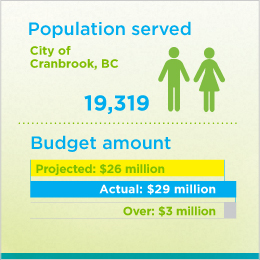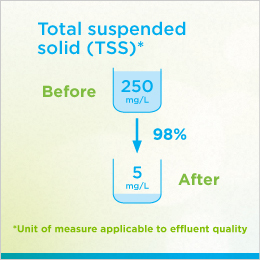This is part of a series of case studies on wastewater projects funded by the FCM's Green Municipal Fund. Each case study provides technical information, project details and tips on best practices.
Project overview
The City of Cranbrook, BC, updated its wastewater treatment system with a new storage pond, two new disinfection facilities and upgrades to its aerated lagoon. The $29 million project includes retrofits to modernize an agricultural irrigation system that reuses wastewater. Fine bubble aeration and UV disinfection help reduce total suspended solids (TSS), biochemical oxygen demand (BOD) and phosphorus levels and improve the quality of wastewater.
To ensure optimum value over the life of the project, the City participated in a value engineering planning exercise, did full-cost accounting and installed process automation features. The upgraded system provides tertiary treatment to the current population of 19,319 and has the capacity to serve 40,000.



Reasons for the project
- A ruling from the BC Environmental Appeal Board (1999) required Cranbrook to create an outfall into the Kootenay River and manage the water levels in one of its treatment lagoons.
Innovative aspects of the project
- The project design made excellent use of systems thinking.
- The system is simple and uses a low-tech approach that is appropriate for a municipality bordering on agricultural lands.
- The upgraded facility makes use of reclaimed water for agricultural application.
Best practices and key lessons
The municipality's experience with this project demonstrates some best practices and key lessons that can inform similar projects.
Develop a long-term vision
- Instead of making piecemeal adjustments simply to achieve minimum thresholds, Cranbrook reviewed the entire system and created a long-term vision for wastewater treatment in the community.
- The city's vision was to become a model of excellence in the use of reclaimed wastewater. This drove short-term planning and generated support from funders and community members.
Engage early and broadly
- The municipality overcame an initial lack of public interest in the project by building relationships with the community, including surrounding rural areas, stakeholders, provincial agencies and First Nations.
- Cranbrook conducted a preliminary archaeological assessment, engaged in dialogue with local First Nations, held open houses, offered tours and updated council regularly.
- These efforts allowed the city to engage with the community as a whole and to address criticisms of past operating practice and negative perceptions of the project.
Conduct background research
- Cranbrook conducted extensive research, including feasibility and pre-engineering studies, during the pre-design process.
- The updated wastewater treatment system uses existing technology in an innovative way that leverages natural systems and processes. For instance, to reduce runoff from irrigation, the system uses low-pressure sprinklers rather than impact sprinklers.
Optimize long-term returns on investment
- To ensure an optimal return on investment, the leadership group involved in the project participated in a value engineering exercise at the design stage.

City of Cranbrook, BC
Project benefits
This project yielded a number of environmental, social and economic benefits.
Environmental benefits
Lower energy usage: The city increased the plant's energy efficiency by replacing high-pressure irrigation heads with low-pressure components, removing pipeline restrictions to reduce the pumping energy required, and installing centralized and automated monitoring pivot irrigation systems.
Reduced greenhouse gas (GHG) emissions: The city replaced three cells in facultative treatment lagoons and converted a facultative effluent storage pond to a high-efficiency bubble diffusion aeration system. These upgrades have reduced the facility's GHG emissions.
Improved wastewater quality: Effluent now meets provincial Ministry of Environment regulatory requirements.
Reduced water consumption: High-efficiency spray nozzles has improved irrigation efficiency and improved absorption, thus reducing irrigation-application rates.
Elimination of chemical residuals: Because UV technology has replaced chlorination as a means of disinfection, the amount of chlorine in effluent is reduced.
Ecosystem protection: Higher-quality effluent leads to healthier wildlife, vegetation and marine life. In addition, the city built a storage pond to avoid accidental spillage of partially treated sewage into a nearby creek.
Reduced odour levels: Odour is reduced through the use of fine bubble diffusers in lagoon cells. Complaints from nearby residents and businesses have been eliminated.
Social benefits
Improved public heath: Residents' health is protected through improved water quality and reduced GHG emissions.
Increased opportunities for recreational and physical activity: Because effluent used for irrigation of feedstock fields is disinfected, these irrigated areas are safe to enter. The public now has access to approximately 2,500 acres of land for recreational and physical activities such as bird watching, dog walking, hiking, cross-country skiing and hunting.
Increased level of service to the community: In addition to improving water quality, the upgrades increased wastewater treatment capacity. The upgraded plant will accommodate population growth for at least 20 more years.
Increased civic pride: Residents show an increasing sense of civic pride and ownership when discussing the attributes of the community.
Municipality recognized for leadership in sustainability: Increasingly, the city is perceived throughout Western Canada as a leader in the treatment of sewage and its reuse in an environmentally responsible manner.
Economic benefits
Reduced maintenance costs: Annual maintenance costs will be reduced because the new equipment will require fewer repairs.
Support for new economic development: The wastewater treatment plant will be able to accommodate commercial and industrial development for a period of 20 years or longer. The improvements resulting from the project will attract new businesses to the area.
Support for residential growth: The wastewater treatment plant will be able to accommodate population growth and additional housing for a period of 20 years or longer.
Support for local business: The city installed new spray technologies on about 28 irrigation pivot systems to water close to 1,800 acres of feedstock fields. This increases crop production and supports the local beef cattle production. Without this source of nutrient-rich water, this industry would not be able to exist in this semi-arid region.
Local job creation: System upgrades have increased irrigation potential and crop yields, creating growth and jobs in the local ranching sector.
Improved operational efficiency: Installation of a SCADA (Supervisory Control and Data Acquisition) system provides a reliable monitoring mechanism and significantly facilitates data retrieval, which can be done remotely.
Development of new partnerships: This project has enabled a potential future partnership with Ducks Unlimited Canada (DUC) to supply effluent to the DUC Oxbow waterfowl nesting and refuge area (approximately one million cubic metres of effluent annually). This would help to maintain sufficient water volume within the Oxbow.

Technical highlights
Technical highlights are current as of 2013.
Treatment
- Before: Aerated lagoon
- After: Aerated lagoon with increased on-site storage and permanent outfall structure on the Kootenay River
Disinfection
- Before: None — 200 CFU/100mL
- After: UV disinfection system — <1 CFU/100mL
Biosolids management
Average annual daily flow (AADF)
- Before: 11.7 MLD (million litres per day)
- After: 8.0 MLD
Biochemical oxygen demand (BOD)
- Before: 30 mg/L
- After: 10 mg/L
Project contact information
Joe McGowan
Director, Infrastructure Planning & Delivery
City of Cranbrook, BC
T. 250-489-0240
Want to explore all GMF-funded projects? Check out the Projects Database for a complete overview of funded projects and get inspired by municipalities of all sizes, across Canada.

